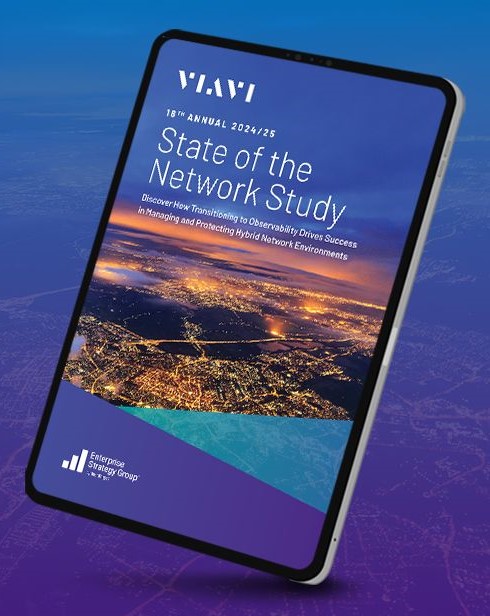
Observability is all about leveraging diverse data sources, including flow, packet data, and metrics, to better understand what is happening inside the network, and what is likely to happen in the future. Therefore, it would not be surprising if more monitoring tools equated to more data and enhanced network observability, but that is not always the case.
There are dozens of Network Performance and Threat Solution (NPTS) tools available to enterprise organizations, each with inherent strengths and benefits. The best results stem from selecting and deploying the right tools for the job and consolidating the toolkit to improve efficiency.
The Tools of the Network Monitoring and Security Trade
Increased network complexity and the advent of hybrid cloud infrastructure have prompted the development of comprehensive solutions, vendor-specific monitoring software, and a plethora of specialized tools for network monitoring, management, and security.
According to the VIAVI 2024/25 State of the Network Study, security incidents remain the type most frequently reported by IT teams, followed closely by network infrastructure and software incidents. This reality is reflected in common tool choices that include:
- Network Performance Monitoring (NPM): 82% of the respondents to our State of the Network Study already utilize NPM, making it the most popular tool category. The best NPM tools incorporate data from multiple sources, including 3rd party cloud environments, while leveraging predictive analytics to improve observability and security practices simultaneously.

- CTEM tools: The ever-present threat of data breaches and other security issues has spurred the development of powerful security practices such as Continuous Threat Exposure Management (CTEM). These tools complement NPM by monitoring network interdependencies and vulnerabilities to reduce the attack surface. Prioritization algorithms ensure the most serious threats are addressed first.

- Infrastructure monitoring: Network performance is intrinsically tied to infrastructure. Infrastructure monitoring tools emphasize the tracking and analyzing of data from network components like servers, storage devices, and network interfaces. As the third most common tool type, infrastructure monitoring solutions support the real-time visibility needed to optimize security issue resolution and pinpoint root cause.
How Many Tools are Too Many?
 Network monitoring teams continue to stock up on specialized tools as they struggle to keep pace with multiple technologies, vendors, and cloud environments. Our State of the Network Study found that respondents deployed an average of 10 discreet monitoring tools.
Network monitoring teams continue to stock up on specialized tools as they struggle to keep pace with multiple technologies, vendors, and cloud environments. Our State of the Network Study found that respondents deployed an average of 10 discreet monitoring tools.
While the reasons behind these oversized tool kits varied, diminishing returns were a familiar refrain: High tool counts correlated with reduced hybrid cloud visibility, slower root cause identification, and a lack of remote worker visibility. In other words, many of the network trends driving the need for more tools become less manageable as tool kits expand.
The Case for Consolidation
Pruning back tools indiscriminately can undermine observability, but consolidating tools to garner more benefits from a smaller tool assortment can improve visibility and network security while reducing training and maintenance tasks. The key is knowing what capabilities are essential and how the tools providing them can work together most effectively.
- Siloed business units and IT teams
Operational siloes are a common byproduct of enterprise growth. This applies to organic growth and cloud migration as well as growth stemming from mergers and acquisitions. Growing numbers of AWS accounts even create siloes within individual teams when interdependencies between accounts go unchecked. As a leading cause of tool propagation, siloes also make it difficult to integrate new technologies and services while managing the overall flow of data.
- Mean time to repair (MTTR)
Our State of the Network Study revealed another compelling reason to consolidate network monitoring tools: Workflow efficiency. Respondents with 10 or fewer tools reported mean time to repair (MTTR) figures 60% faster than those with 11 or more tools. This dramatic difference highlighted the conflicting information and reports that hamper response teams managing multiple platforms. These precious lost minutes jeopardize the user experience while giving threat actors more time to gain a foothold.
- Unified visibility and control
When attempting to establish end-to-end visibility, correlate data from multiple sources, and pinpoint issues faster while minimizing blind spots, it makes sense to establish a common interface that provides the same real-time performance and security insights to all stakeholders. Modular tools purpose-built for interoperability allow the toolset to scale without growing pains.
A unified approach works best when these purpose-built elements are feeding data to a centralized software solution. This platform becomes a single source of truth hosting interactive dashboards, reports, and dependency maps. The VIAVI Observer Platform with dedicated packet capture, flow record generation, and CTEM modules minimizes the data siloes and interoperability issues that plague disjointed toolkits.
Introducing the VIAVI 2024/25 State of the Network Study
The 16th annual 2024/25 VIAVI State of the Network Study is now available. Insights culled from over 750 networking and security professionals highlight the role of formal observability strategies in taking service delivery and network security to the next level. Get access to the study results now.
Get the study:

